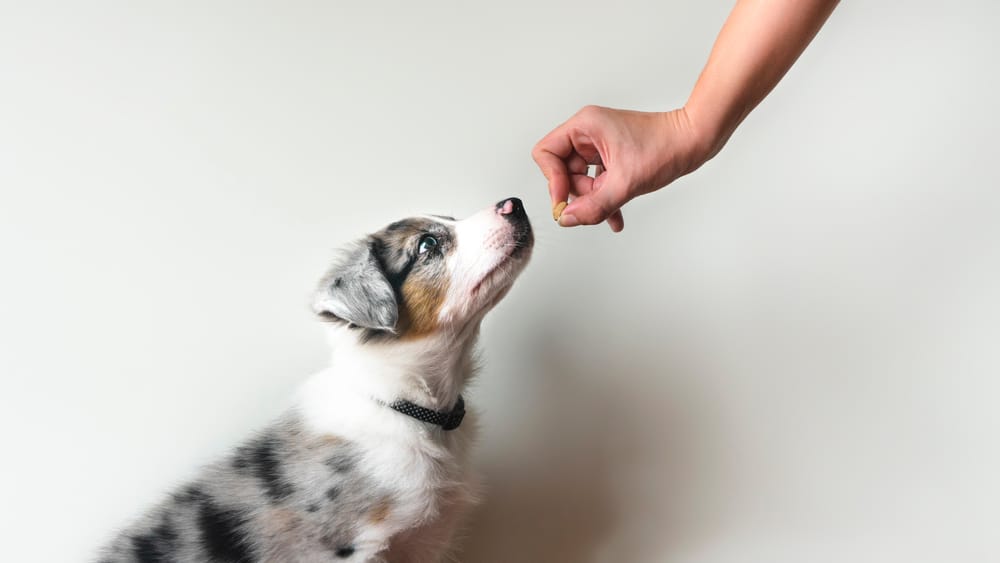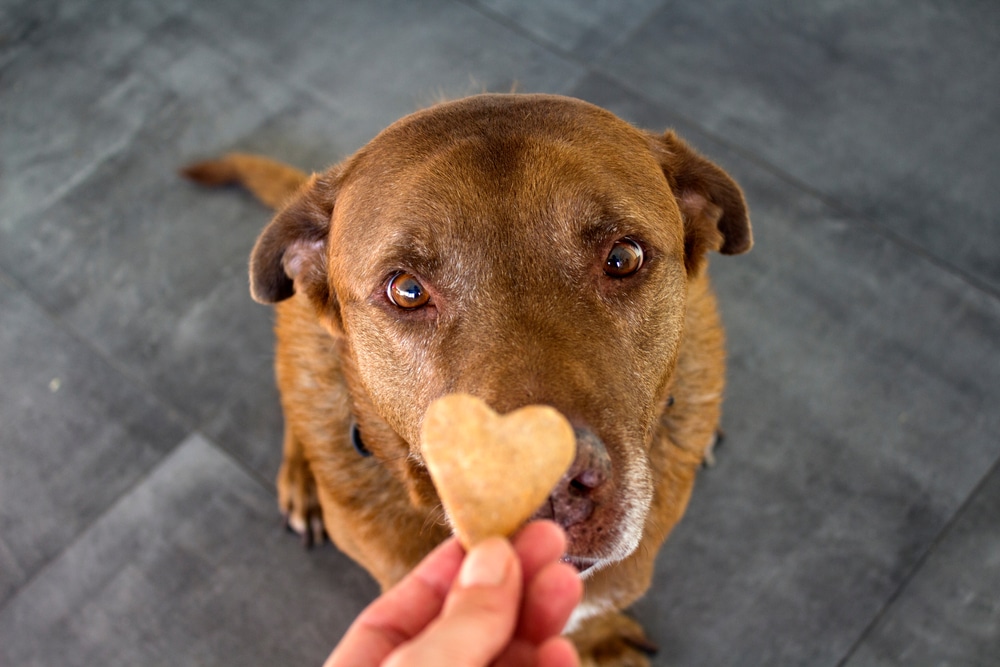Many experts recommend counterconditioning to help anxious dogs overcome their fear of certain situations. But you may wonder, just what is counterconditioning?
Counterconditioning is a behavioral technique used to change a dog’s negative feeling or mood that is currently associated with a specific stimulus. For example, a dog that is afraid during a thunderstorm can be taught to be calm and positive by associating the situation with a reward using counterconditioning.
Table of Contents
How Does Counterconditioning Work?

Dogs often have a negative response to a neutral stimulus either due to an unpleasant past encounter or simply a fear of the unknown. A dog that visits the dog park frequently will likely have a positive and excited response to car rides, whereas a dog whose only car rides end up at the vet will be fearful. In this case, we want to change the dog’s negative association with car rides into a positive one.
Counterconditioning provides your dog with a consistently positive experience to look forward to whenever they encounter the situation that previously caused them anxiety or fear. It is important to remember that counterconditioning aims to change your dog’s feelings about the situation rather than their behavior.
The most common way to countercondition your pet is by rewarding them with yummy treats throughout the negative experience. The idea is to make your dog look forward to the situation rather than be afraid of it. In order to achieve this, you must begin feeding treats as soon as the scary experience starts and keep them flowing throughout. As soon as the stimulus stops or goes away, the treats stop too. Soon your dog will begin to realize that the appearance of the stimulus brings a free flow of treats, and they will become less afraid.
In order for this method to succeed, you must always have treats on hand to give them every single time the stimulus appears; only treating them sometimes will make it harder to create the positive association that helps your dog be less afraid.
Identifying Your Dog’s Fears
As owners, it is important that we are able to read our dog’s body language to identify which experiences they find scary. Acknowledging the fear is the first step in taking steps to resolve it.
A dog that is afraid will often show a change in its behavior in response to the scary thing that is happening. For instance, a dog that is afraid of fireworks will startle as the noise commences and may put on a worried face, with its eyes wide, ears pulled back, and mouth closed. Other signs include:
- Crouching
- Tucking their tail between their legs
- Hiding under or behind furniture
- Lip licking
- Avoiding eye contact
- Panting
- Yawning
- Whimpering
- Shivering
- Urinating or defecating
The intensity of the fear response also depends on the dog, and some will show fewer of these signs while others may display many or all of them.
Similar to how some people are afraid of the dark but others aren’t, a dog’s fears are also individual. That being said, some of the most common canine stressors include car rides, vet visits, nail trims, seeing strange humans or dogs, and loud noises like fireworks, vacuum cleaners, or thunderstorms.
Desensitization
Often used in tandem with counterconditioning, desensitization refers to the process of exposing your dog to small incremental doses of the scary thing so it can gradually become accustomed to it.
For instance, begin desensitizing a dog that is afraid of thunderstorms before it even happens by playing a recording of thunder sounds at low volume while counterconditioning them with treats at the same time. Observe your dog for signs of stress and keep the sessions short. When your dog seems comfortable and relaxed, move on to the next phase by gradually increasing the volume. If your dog appears afraid at any point, backtrack immediately and go slower.
How To Tell If Counterconditioning Is Working
A dog that has been successfully counterconditioned will be less anxious or fearful the next time they encounter the scary stimulus. It will have little or no change in its behavior and maintain contented body language, with its mouth relaxed and open and a happily wagging tail.
Why The Counterconditioning May Not Be Going So Well
Let’s start with the rewards.
Your Rewards Aren’t Exciting Enough
In order for this technique to work, the food you are offering must be good enough for your dog to momentarily forget its fear and focus on the treat instead.
So, identify your dog’s favorite snacks beforehand by lining up a few options and seeing which one it goes for. Some common favorites are chicken, beef jerky, cheese, and peanut butter.
The Positive Experiences Are Inconsistent
The most common reason for failure is that many owners aren’t prepared to provide a positive experience when the scary stimulus appears unexpectedly. For instance, if a thunderstorm suddenly starts up while you and your dog are out for a walk, you must have treats on-hand to continue counterconditioning so that your dog successfully learns that thunderstorms always mean treats and are, therefore, not scary.
You’re Going Too Fast
If you expose your dog to too much of the scary thing all at once, it will be harder for it to overcome its fear. Think of desensitization like lifting weights at the gym. If you add too much weight before you’re ready, you won’t be able to complete the full motion of the exercise and will likely lose out on the benefits (or even injure yourself). It is important that we learn to read our dogs for signs of fear and follow their pace during training.
You’re Using The Wrong Techniques
Because we’re trying to change the emotion rather than the behavior, using behavioral training techniques such as clicker training and negative reinforcement may not be suitable for helping your dog overcome their fears.
Clickers are used to mark a desired response. So, using one in this situation may produce an unwelcome result, such as teaching your dog that hiding or showing signs of fear is what earns it its reward.
Negative reinforcement uses unpleasant experiences to teach dogs certain behaviors. Using negative reinforcement causes your dog more anxiety in an already stressful situation and should be avoided.
Additionally, treat your dog during the stressful event regardless of what their response may be. Keep in mind that with counterconditioning, we are trying to change your dog’s emotions rather than their response, and consistency is important!
A Final Remember To Keep Your Dog’s Diet In Mind
With all the focus on overcoming fears, it can be easy to overlook your dog’s food intake. Remember to factor in the extra calories from treats when planning your dog’s meals for the day to avoid serious health complications such as obesity. Check with your veterinarian before introducing any new treats, and watch out for any signs of an upset stomach.
Conclusion: What Is Counterconditioning?
Counterconditioning uses an artificial positive experience to help your dog learn to like something that they are afraid of. Usually used with desensitization, it works to change your dog’s fearful or anxious response to a situation into a relaxed or happy one. Because your dog learns that when the scary stimulus appears, they can expect to receive yummy treats, they learn to look forward to the situation rather than fear it.
This method takes time and requires lots of patience to be successful. But with practice and consistency, you can help your dog overcome their fears and be much more contented.
So, how do you plan to use counterconditioning for your dog? What are they struggling with? Let us know in the comments below!
